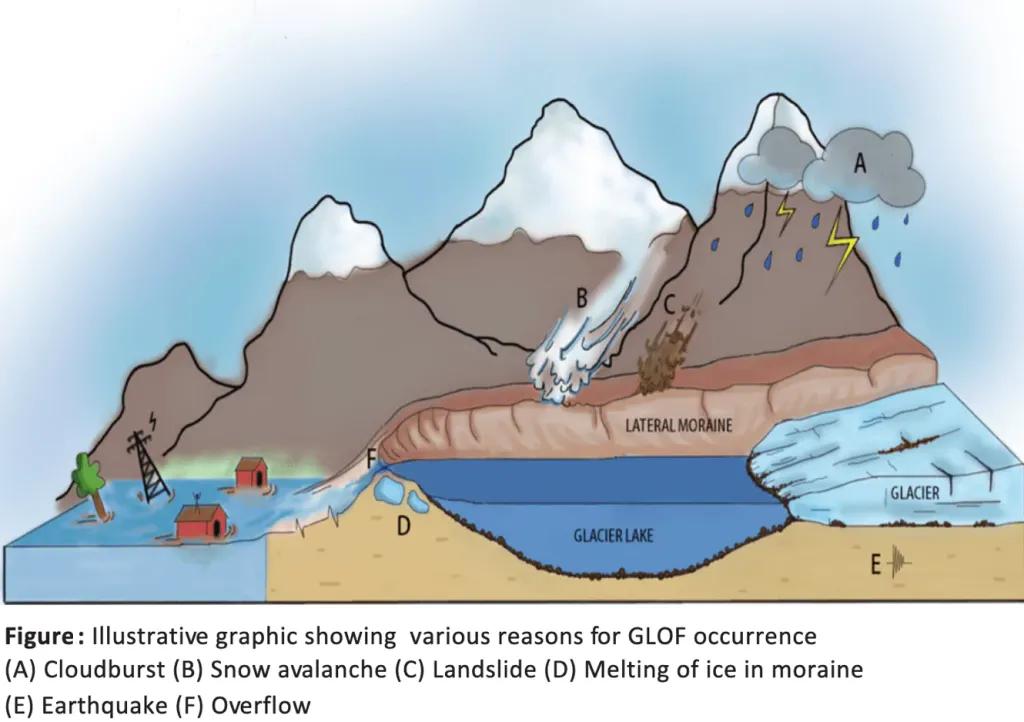-
Q. Discuss the causes of Glacial Lake Outburst Floods (GLOFs) in the Himalayas. What measures can be taken to mitigate the risks associated with GLOFs? (250 words)
05 Aug, 2024 GS Paper 1 GeographyApproach
- Introduce the answer by defining the GLOFs
- Give causes of GLOFs in the Himalayas
- Highlight the Mitigation Measures
- Conclude positively.
Introduction
Glacial Lake Outburst Floods (GLOFs) occur when a glacial lake suddenly releases a massive volume of water, often due to the failure of a natural dam or other containing structure.
- These events can unleash destructive floods, carrying enormous amounts of water, sediment, and debris downstream at high speeds.
- In recent years, the frequency and intensity of GLOFs in the Himalayas have increased, primarily due to climate change and its cascading effects on the fragile mountain ecosystem.
Body
Causes of GLOFs in the Himalayas:
- Climate Change and Global Warming: Climate change is accelerating glacial melting in the Himalayas, leading to the rapid formation and expansion of glacial lakes.
- Rising temperatures or erratic rainfalls cause ice to melt at unprecedented rates, increasing the volume of water in these lakes.
- A prime example is the 2013 Uttarakhand Floods.
- Cloudburst: Intense rainfall events, often referred to as cloudbursts, can rapidly increase water levels in glacial lakes, leading to instability and potential breaches in the moraine dams.
- A prime example is the June 2023 GLOF in North Sikkim.
- Seismic Activity: The Himalayan region's high seismic activity poses a constant threat to glacial lake stability.
- Earthquakes can damage natural dams, trigger landslides into lakes, or cause sudden shifts in glacial structures.
- The 2015 Nepal earthquake, for instance, caused significant changes in numerous glacial lakes across the region, substantially increasing GLOF risks in its aftermath.
- Avalanches and Landslides: Mountainous terrain makes the Himalayas prone to avalanches and landslides, which can have catastrophic effects on glacial lakes.
- These events can cause sudden water displacement or breach containment structures.
- A tragic example occurred in 2021 Uttarakhand's Chamoli district, where a landslide triggered a devastating GLOF.
- Weak Moraine Dams: Many Himalayan glacial lakes are contained by natural moraine dams, formed from loose glacial debris.
- These structures are often inherently weak and prone to failure, especially when subjected to additional stressors.
- The 1985 Dig Tsho GLOF in Nepal serves as a classic example, where the failure of a weak moraine dam led to a catastrophic flood event.
Mitigation Measures:
- Early Warning Systems (EWS): Implementing well structured Early Warning Systems like use of Synthetic-Aperture Radar imagery is crucial for GLOF risk mitigation.
- These systems involve real-time monitoring of glacial lakes, automated alert mechanisms, and community-based warning networks.
- Controlled Lake Drainage: Proactive management of glacial lake water levels through controlled drainage can significantly reduce GLOF risks.
- This involves carefully planned engineering interventions to gradually lower lake volumes to safer levels.
- Infrastructure Reinforcement: Strengthening existing man-made dams and constructing protective structures through Uniform Codes for Construction Activity along with balancing hydropower development can enhance resilience against GLOFs.
- This includes techniques like reinforcing moraine dams, building spillways, and constructing flood protection barriers.
- Community-based Disaster Preparedness: Empowering local communities with knowledge and skills for GLOF preparedness is essential.
- This involves conducting regular drills, creating evacuation plans, and establishing community-led monitoring systems.
- Transboundary Cooperation: Given the cross-border nature of many Himalayan glacial systems, international cooperation is vital for effective GLOF management.
- This includes sharing data, coordinating monitoring efforts, and jointly developing mitigation strategies.
Conclusion
The threat of Glacial Lake Outburst Floods in the Himalayas demands urgent and comprehensive action. Long-term mitigation requires sustained international cooperation, continued research, and integration of GLOF management into broader climate adaptation plans.
To get PDF version, Please click on "Print PDF" button.
Print PDF





